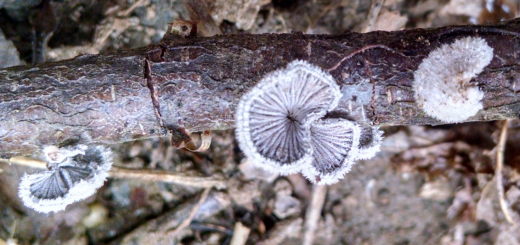#022: Nematode-Trapping Fungi
Fungi have developed a variety of ways to trap and kill nematodes. These include: adhesive branches, adhesive knobs, adhesive networks, non-constricting rings, and constricting rings. None of these fungi use nematodes as a primary food source. However, fungi sometimes need extra nutrients, especially nitrogen. Forming traps is very energy-intensive, so they are only formed when nutrients are scarce and nematodes are present. Fungi detect nematodes by “eavesdropping” on ascarosides, the chemicals that nematodes use to communicate with each other. If you want to see these fungi in action and/or get a better understanding of nematophagous fungi, watch the YouTube video (in two parts) linked below*. For your convenience, I have noted the time at which each type of trap is discussed in the video.
Adhesive branches (part 1, 10:01): these are the simplest of the nematode traps. They consist of short branches that are formed off of the main hypha and are covered in an adhesive substance. When a nematode brushes against the adhesive branch, it becomes glued to the hypha. The branch then produces infection structures that penetrate the nematode’s cuticle. Hyphae then grow throughout the nematode from the infection point, dissolving the nematode’s tissues and absorbing the nutrients. All nematode-trapping fungi infect their prey in a similar manner.
Adhesive knobs (part 1, 7:33): these are branches off of the main hypha that end in a circular cell covered in an adhesive. These knobs may be loosely or firmly attached to the hypha. Loosely attached knobs can break off from the main hypha once attached to a nematode. The nematode can then carry the knob around, helping to spread the fungus. Firmly attached knobs do not break off of the main hypha and keep the nematode in place.
Adhesive networks (part 1, 13:12 or part 2, 0:00): these are three-dimensional, net-like structures coated in an adhesive. The nematode can become trapped by either swimming through the net or by brushing up against the side of the net.
Non-constricting rings: these adhesive-coated rings are composed of three hyphal compartments and are connected to the main hypha by a short stalk. As in the adhesive networks, the nematode can become trapped by either swimming through the ring or by brushing up against the side of the ring.
Constricting rings (part 2, 1:47): these are the most complex nematode-trapping structures. Like the non-constricting rings, they are composed of three hyphal compartments and are attached to the main hypha by a short stalk. However, they do not secrete an adhesive. Instead, they quickly constrict when touched by a nematode, thus securely trapping it. This constriction is accomplished by a signal transduction cascade that results in the cells becoming rapidly flooded with water (thus expanding to almost completely close the ring). Despite the fact that both types of rings are composed of three hyphal compartments on a short stalk, they are not evolutionarily related to each other. This is an example of convergent evolution, where the same structure has evolved multiple times in response to the same or similar conditions.
Other fungi have found more ways to attack nematodes. Pleurotus ostreatus secretes toxins that paralyze the nematode before colonization by hyphae (part 2, 5:24, see FFF#021). Other fungi use normal hyphae to infect nematode eggs (part 2, 3:29). There are also a number of endoparasitic fungi that are obligate parasites of nematodes (all hyphal growth occurs inside the nematode, only the spores and reproductive structures are present in the external environment, part 1, 1:33).
See Further:
http://microbewiki.kenyon.edu/index.php/Nematode_trapping_fungi
* http://www.youtube.com/watch?v=14zmmbXsyuM (part 1)
* http://www.youtube.com/watch?v=Uktd10jLPAM (part 2)
http://www.biological-research.com/philip-jacobs%20BRIC/index.htm
http://www.uea.ac.uk/biological-sciences/engagement/fascinating-fungi/nematode-trapping-fungi
http://www.sciencedaily.com/releases/2012/12/121213145257.htm








![#011: Characteristics of Kingdom Fungi [Archived]](https://www.fungusfactfriday.com/wp-content/themes/hueman/assets/front/img/thumb-small-empty.png)

1 Response
[…] One of the interesting things about P. ostreatus is that it attacks and kills nematodes. When nematodes are present, the Oyster Mushroom’s hyphae produce many sticky knobs on the sides of the cells. These secrete nematotoxic chemicals that paralyze and kill the nematodes. The fungus then produces specialized hyphae that penetrate and digest the worms. There are two reasons that the fungus would do this. First, it is a defense mechanism that prevents the nematodes from feeding on the fungal cells. Second, the nematodes supply an extra source of nitrogen. The fungus does not need an extra food source, but nitrogen is often in short supply in long-dead material.6,7 (For more on fungi that eat nematodes, see FFF#022.) […]